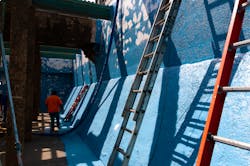Texarkana Water Utilities Clarifier Rehabilitation
Texarkana Water Utilities rehabilitated a concrete clarifier in their Millwood Potable Water Treatment Plant to effectively treat potable water.
The Problem
The concrete floor and sidewalls of the clarifier in the potable water treatment facility were severely deteriorated. There were areas of cracking, spalling and even leaking concrete that called for extensive repairs. Local regulation requires that the clarifier be repaired and brought back to a water tight, operable state. In water treatment facilities where potable water contacts the coating, the products utilized must be NSF Standard 61 approved to ensure that harmful contaminants do not leach into the water. So, this project required careful specification development to ensure proper cleaning repair and application of immersion-grade coatings.
The Solution
First, the concrete was prepared with a 5,000 psi power wash utilizing an acid etch solution to achieve an ICRI 310.2 CSP-4 concrete surface profile. ICRI 310.2 CSP-4 is one of ten classifications of surface textures developed by the International Concrete Repair Institute (ICRI). These classifications are accepted as industry standards that guide the installer on how to achieve the proper degree of surface roughness for successful bonding of a given overlay or coating. CSP-4 is the recommended roughness for applying high build coatings (0.1 in.) and is usually achieved on vertical surfaces by using a granular blast seven or a shot blast.
Next, SikaTop123, a two component, polymer-modified, fast-setting, non-sag mortar, was used to fill the eroded and cracked areas of the concrete. SikaTop 123 was specified because it is NSF Standard 61 approved for contact with potable water.
Then, Induron’s AquaClean epoxy was used as a prime coat to mitigate out gassing. Because concrete is porous by nature, its “breathing” often leads to pin holes in the coating as air moves in and out of the concrete slab. This can lead to water soaking into the concrete and eventually potential for coating failure. AquaClean was specified because of its flow, wetting ability, high adhesion to concrete, ability to easily be applied in a thin film of .004 to .006 in. and is NSF Standard 61 approved.
Induron’s PermaClean 100 was used as a barrier coating because of its film build and ultra-low permeability. PermaClean 100 was previously NSF approved for .05 in., but to meet the needs of this particular project, the company had the product NSF Standard 61 tested and re-certified for .15 in. in three coats. Having PermaClean 100 NSF Standard 61 certified for additional inches was one of the largest hurdles of the project.
The Challenge
While federal law requires only that the top coat which is designed for water contact be NSF Standard 61 approved, on this project, use of NSF Standard 61 approved products in all phases was necessary to comply with the Arkansas Health Department’s requirement, “All surfaces that come into contact with potable water must have an NSF-approved product from the top of the film to the concrete substrate.”
NSF certification is a key mechanism for ensuring that products meet strict standards for public health protection. Products must undergo extensive testing and material analyses, as well as unannounced plant inspections to evaluate every aspect of the product’s development before it can earn an NSF Standard 61 certification. NSF Standard 61 certification is not a one-time event. It involves regular onsite inspections of manufacturing facilities and regular re-testing of products to ensure that they continue to meet the same high standards required to maintain certification over time.
Because the Induron products required for this project were NSF Standard 61 certified, the company successfully worked with Bazan Painting Co. to rehabilitate the clarifier and ensure that it complied with Arkansas’ health regulations.

